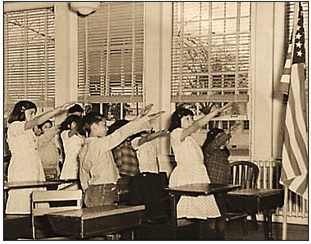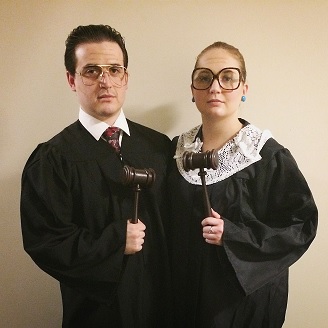
Stuff You Really Don’t Want To Know (But For Some Reason Have To) About the Jehovah’s Witnesses Flag Cases (Part One)
Arguably no religious group faced more persecution and hostility in the 20th century United States than the Jehovah’s Witnesses. They proselytized aggressively in the streets and went door-to-door offering copies of The Watchtower and wanting to talk about the “end times.” They were not a group known for political engagement. They didn’t usually vote, most rejected Social Security numbers as a “mark of the beast,” and leadership discouraged serving on juries or other forms of civic participation. Believers were expected to work for a living, obey the law, and “render unto Caesar” – as long as it did not explicitly conflict with the Word of God.
Despite all this, the Jehovah’s Witnesses have arguably done more than any other religious group to promote freedom of religion and freedom of speech in the U.S. To date, they’ve been involved in something like two dozen U.S. Supreme Court cases, almost all of them concerned with First Amendment protections. The vast majority occurred in the 1930s and 1940s.
In the waning years of the Great Depression, as Europe stumbled towards war, patriotism in the United States became mandatory in all but name. Many states passed laws requiring all public school students to salute the American Flag and say the Pledge of Allegiance each day, apparently assuming that nothing promotes heartfelt commitment like mandatory obeisance. If you’ve seen pictures from the era, you may notice that the standard salute looked different than it does today. Typically, it involved the right arm extended forward and upwards at a slight degree towards the flag as participants chanted in unison their devotion to the collective.
In Nazi Germany, a very similar salute was required of all good citizens, although in the faterland, nationalism was personified in their new Chancellor, Adolph Hitler, rather than a mere flag. Jehovah’s Witnesses in Germany refused to salute, citing the Second Commandment – “Thou shalt have no other gods before me” – as well as several other Old Testament passages suggesting that the Lord Their God was not a fan of split allegiances. Joseph F. Rutherford, who succeeded Witnesses founder and leader Charles Taze after his death in 1916, suggested American Jehovah’s Witnesses avoid what they saw as similar oaths back home.
 German Jehovah’s Witnesses would soon be sent to their deaths in various Nazi concentration camps, while their American counterparts were merely mocked, harassed, accused, and periodically assaulted. The official eruption of World War II in 1939 only increased these tensions, despite the U.S. managing to avoid direct involvement for the first few years. Meanwhile, some Jehovah’s Witnesses schoolchildren who took their beliefs a bit too seriously for the comfort of the masses became the focal point for what had heretofore been scattered and inconsistent suspicion and hostility.
German Jehovah’s Witnesses would soon be sent to their deaths in various Nazi concentration camps, while their American counterparts were merely mocked, harassed, accused, and periodically assaulted. The official eruption of World War II in 1939 only increased these tensions, despite the U.S. managing to avoid direct involvement for the first few years. Meanwhile, some Jehovah’s Witnesses schoolchildren who took their beliefs a bit too seriously for the comfort of the masses became the focal point for what had heretofore been scattered and inconsistent suspicion and hostility.
Minersville School District v. Gobitis (1940)
Lillian Gobitas (the name was later misspelled in court records), age 12, and her brother Billy, age 10, refused to participate in the Pledge of Allegiance. They believed the Bible forbid such direct promises of obedience to anything or anyone other than the Lord God, and were expelled from school as a result. Their case eventually reached the Supreme Court, which determined in an 8 – 1 vote that the school had the right to require the Pledge as part of promoting good citizenship. It wasn’t a violation of Constitutional rights because the requirement didn’t target their religion intentionally.
From the Majority Opinion by Justice Felix Frankfurter:
The ultimate foundation of a free society is the binding tie of cohesive sentiment. Such a sentiment is fostered by all those agencies of the mind and spirit which may serve to gather up the traditions of a people, transmit them from generation to generation, and thereby create that continuity of a treasured common life which constitutes a civilization… The flag is the symbol of our national unity, transcending all internal differences, however large, within the framework of the Constitution…
The wisdom of training children in patriotic impulses by those compulsions which necessarily pervade so much of the educational process is not for our independent judgment. Even were we convinced of the folly of such a measure, such belief would be no proof of its unconstitutionality… But the courtroom is not the arena for debating issues of educational policy. It is not our province to choose among competing considerations in the subtle process of securing effective loyalty to the traditional ideals of democracy, while respecting at the same time individual idiosyncracies among a people so diversified in racial origins and religious allegiances.
Justice Harlan Stone wrote one of the most famous dissenting opinions in Court history in response. Several of his points would be revisited when a new majority overturned Minersville a mere three years later. Behold the power of a well-penned dissent:
The law which is thus sustained is unique in the history of Anglo-American legislation. It does more than suppress freedom of speech, and more than prohibit the free exercise of religion, which concededly are forbidden by the First Amendment and are violations of the liberty guaranteed by the Fourteenth. For, by this law, the state seeks to coerce these children to express a sentiment which, as they interpret it, they do not entertain, and which violates their deepest religious convictions…
History teaches us that there have been but few infringements of personal liberty by the state which have not been justified, as they are here, in the name of righteousness and the public good, and few which have not been directed, as they are now, at politically helpless minorities…
The Constitution may well elicit expressions of loyalty to it and to the government which it created, but it does not command such expressions or otherwise give any indication that compulsory expressions of loyalty play any such part in our scheme of government as to override the constitutional protection of freedom of speech and religion. And while such expressions of loyalty, when voluntarily given, may promote national unity, it is quite another matter to say that their compulsory expression by children in violation of their own and their parents’ religious convictions can be regarded as playing so important a part in our national unity as to leave school boards free to exact it despite the constitutional guarantee of freedom of religion.
The Red, White, Black & Blue
While there were vocal critics of the Gobitis decision, especially in the press, many Americans took it as federal validation of whatever they wished to do to Jehovah’s Witnesses in their area. Violence against believers surged dramatically, often times with local law enforcement standing by but refusing to interfere – no doubt out of some degree of personal prejudice, but now with the perceived sanction of the nation’s highest court.
 We like to imagine the Supreme Court as remaining safely beyond the pale of popular opinion or social forces, but they are at times quite human and may even read the news from time to time. The makeup of the Court evolves as well, and shortly after the Gobitis decision, it changed rather dramatically. Chief Justice Charles E. Hughes retired, as did Justice McReynolds. Justice Stone, author of the sole dissent in Gobitis, was promoted to Chief Justice, and Justices Robert Jackson and Wiley Rutledge joined the Court.
We like to imagine the Supreme Court as remaining safely beyond the pale of popular opinion or social forces, but they are at times quite human and may even read the news from time to time. The makeup of the Court evolves as well, and shortly after the Gobitis decision, it changed rather dramatically. Chief Justice Charles E. Hughes retired, as did Justice McReynolds. Justice Stone, author of the sole dissent in Gobitis, was promoted to Chief Justice, and Justices Robert Jackson and Wiley Rutledge joined the Court.
Jones v. City of Opelika was a case first considered by the Court in 1941 and once again involved Jehovah’s Witnesses. The issue was whether or not the State can charge “licensing fees” on religious books and pamphlets. The Court initially determined that they could. Justices Hugo Black, William Douglas, and Francis Murphy – all of whom had voted with the majority in Gobitis – added a dissent in which they repudiated their previous decision:
The opinion of the Court {in Jones v. Opelika} sanctions a device which, in our opinion, suppresses or tends to suppress the free exercise of a religion practiced by a minority group. This is but another step in the direction which Minersville School District v. Gobitis (1940) took against the same religious minority, and is a logical extension of the principles upon which that decision rested. Since we joined in the opinion in the Gobitis case, we think this is an appropriate occasion to state that we now believe that it was also wrongly decided.
Certainly our democratic form of government functioning under the historic Bill of Rights has a high responsibility to accommodate itself to the religious views of minorities, however unpopular and unorthodox those views may be. The First Amendment does not put the right freely to exercise religion in a subordinate position. We fear, however, that the opinions in these and in the Gobitis case do exactly that.
Jones was reconsidered the following session, and in 1942 the Court reversed itself on this Neo-Stamp Act. Combined with the comments of Black, Douglas, and Murphy, it was clear that the winds of jurisprudential change were blowing – and briskly.
As it turned out, those little Jehovah’s Witnesses kids still refused to have other gods before the Big One. It was a mere three years before almost the exact same “Heil ‘Merica!” case came before the High Court once again. The second time, the results would be a tiny bit different.
H2H Minersville v Gobitis (1940) – PDF
NOTE: The online version of this article is a rough draft from “Have To” History: A Wall Of Education. The attached PDF version is from the final, published version of the book.
